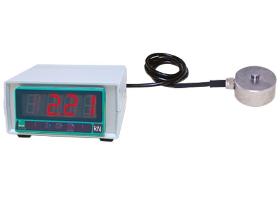- europages
- >
- COMPANIES - SUPPLIERS - SERVICE PROVIDERS
- >
- force sensors- electrical
Results for
Force sensors- electrical - Import export

BURSTER PRÄZISIONSMESSTECHNIK GMBH & CO KG
Germany
Inside the multi-component force transducer are two webs, each offset by 90°, each with a strain gage full bridge, which convert the radially acting X / Y forces on the guide bush into an electrical signal. Due to the sensor body made from a block with its special structure, the sensor has a very high degree of dimensional accuracy and low crosstalk between the two forces. Due to the special design, the sensor has excellent linearity properties and is designed for a long service life in dynamic applications. The two independent signal connections allow flexible adaptation and further processing. Features: — Measuring ranges: 0 ... 4448 N / 0 ... 2224 N (0 ... 1000 lbs / 0 ... 500 lbs); 0 ... 8896 N / 0 ... 4448 N (0 ... 2000 lbs / 0 ... 1000 lbs) — Further measuring ranges on request — Non-linearity < 0.1 % F.S. — Low cross talk < 0.75 % F.S. — High dimensional accuracy, because sensor is made from one part — Excellent price/performance ratio
Request for a quote
BURSTER PRÄZISIONSMESSTECHNIK GMBH & CO KG
Germany
The force measuring chain is an universal reference measuring chain for the calibration of press-fit force measuring equipment. It finds applications in the quality assurance, commissioning and equipment monitoring fields. A DAkks calibration certificate is included so that the force measuring chain can be traced back. The calibration is traceable through accreditation at the German Accreditation Body. The calibration certificate records the displayed values for mounting positions at 0°, 120° and 240°. During calibration in field, the reference load cell is inserted in line with the flux of the press-fit measuring equipment. The force application is of central significance here for the quality of the measurement. Special force application parts are required, so that the line of action of the force agrees as exactly as possible with the geometrical axis of the load cell that is to be measured (central loading).
Request for a quote
BURSTER PRÄZISIONSMESSTECHNIK GMBH & CO KG
Germany
The force to be measured must be introduced axially and perpendicularly to the entire surface of the inner and outer bands of the sensor in the opposite direction. Conversion of the acting force into an electrical output signal is performed by strain gages connected together in a full bridge circuit. To achieve optimal accuracy, the base of the sensor should rest on a smooth level surface, hardened to at least ≥ 58 HRC with sufficient dimensions. The base cover welded to the surface has a stabilizing effect on the sensor element. Lateral forces must be avoided anyway as they distort the measured results. Tension and bending relief for the sensor cable is to be carried out on the machine side. FEATURES: — Measuring ranges from 0 ... 100 N to 0 ... 200 kN — Centric throughout hole — Flat disc design — Made of stainless steel — Completely welded sensor body — Nominal characteristic value standardization possible — burster TEDS optionally available
Request for a quote
BURSTER PRÄZISIONSMESSTECHNIK GMBH & CO KG
Germany
The force measuring chain has been developed for applications where the requirements for precision are not the primary focus, but rather where an economical purchase price and simple functionality are the key criteria. The sensor‘s strain gauge technology allows both static and dynamically changing forces to be measured. The large display means that the force acting on the sensor can be read easily. The four integrated threaded holes allow the sensor to be integrated quickly and easily into existing production and assembly equipment. Typical applications include: —Testing the strength of welded joints —Sports medicine —Monitoring the clamping force of hose connections The body of the sensor is a flat, cylindrical disk, into which a domed force application knob is integrated. It is important that the force is applied axially to the center of the sensor.
Request for a quote
TEST GMBH
Germany
The small dimensions of the hydraulic force transducers of the model series TesT 1001 / 1011 / 1021 as well as the flat building method permit versatile applications. The small transducers were conceived for occasional control measurements, e.g. for adjusting or service work. The indicating instruments of model versions 1001 and 1011 have a diameter of 63 mm. The indicating instrument of model version 1021 can have a diameter of 63 mm or 100 mm. All model versions possess a drag indicator to display peak values.
Request for a quoteDo you sell or make similar products?
Sign up to europages and have your products listed
Results for
Force sensors- electrical - Import exportNumber of results
5 ProductsCountries
Company type
Category